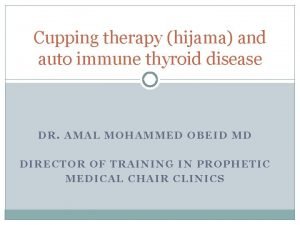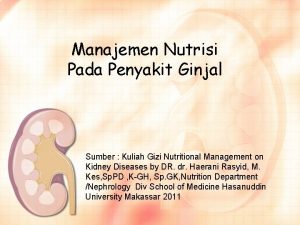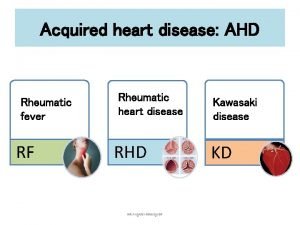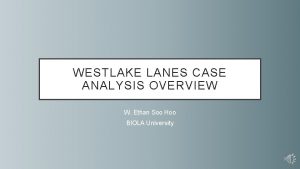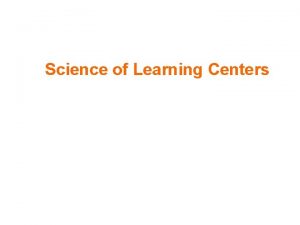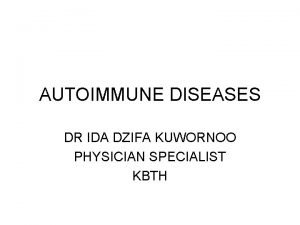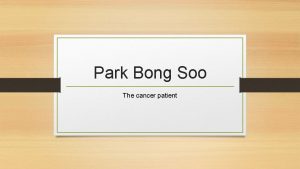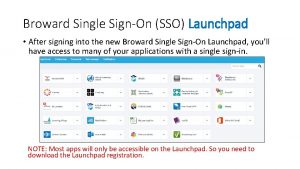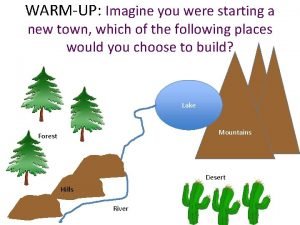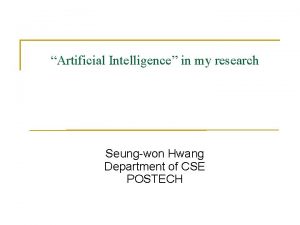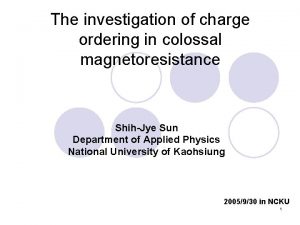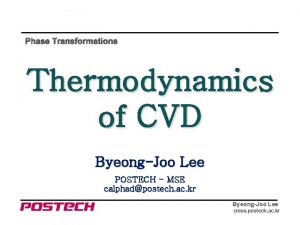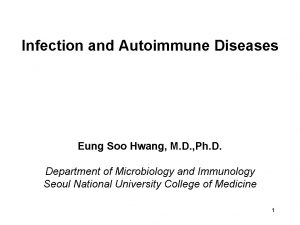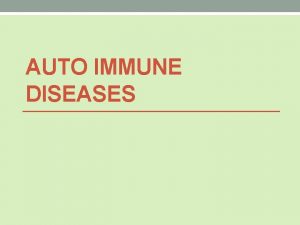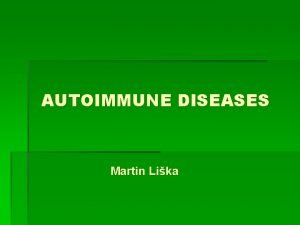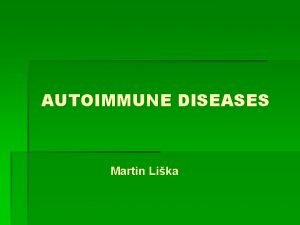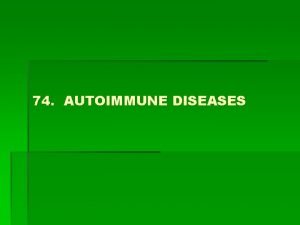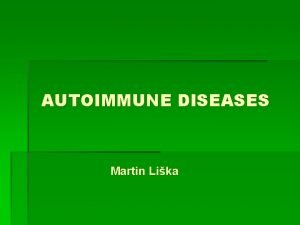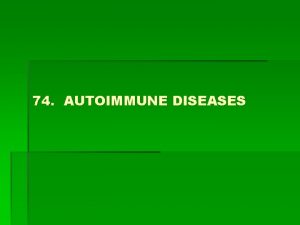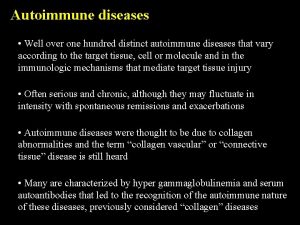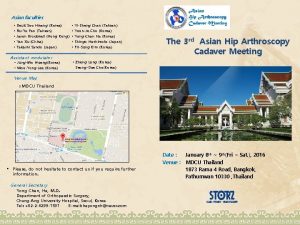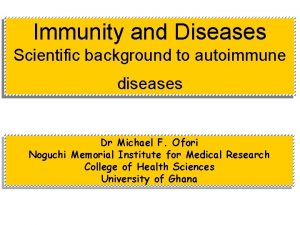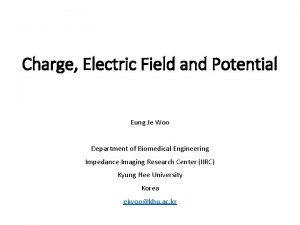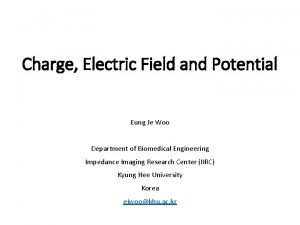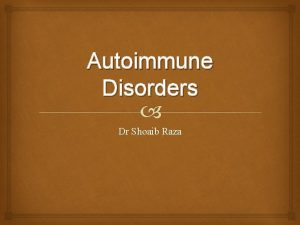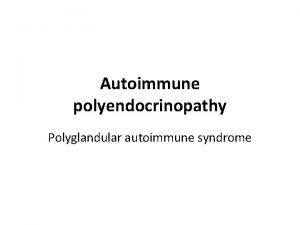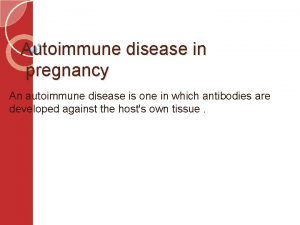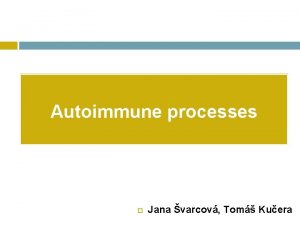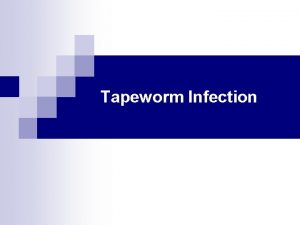Infection and Autoimmune Diseases Eung Soo Hwang M

![[Learning Objectives] 1. List autoimmune diseases caused by microbial agents 2. List microbial agents [Learning Objectives] 1. List autoimmune diseases caused by microbial agents 2. List microbial agents](https://slidetodoc.com/presentation_image/237c7e49fa6ff7a1187a644600d248eb/image-2.jpg)





















- Slides: 23

Infection and Autoimmune Diseases Eung Soo Hwang, M. D. , Ph. D. Department of Microbiology and Immunology Seoul National University College of Medicine 1
![Learning Objectives 1 List autoimmune diseases caused by microbial agents 2 List microbial agents [Learning Objectives] 1. List autoimmune diseases caused by microbial agents 2. List microbial agents](https://slidetodoc.com/presentation_image/237c7e49fa6ff7a1187a644600d248eb/image-2.jpg)
[Learning Objectives] 1. List autoimmune diseases caused by microbial agents 2. List microbial agents associated with autoimmune diseases 3. List mechanisms of autoimmunity caused by microbial agents

I. Mechanisms for activation of autoreactive T and B cells by infectious agents (1) Molecular mimicry (2) Viral and bacterial superantigens (3) Enhanced processing and presentation of autoantigens (4) Bystander activation (5) Activation of lymphocytes by lymphotropic viruses 2

(1) Molecular mimicry Activation of autoreactive T cells by microbial peptides that have sufficient structural similarity to self-peptides 3

Expansion of Autoreactive T cells: TCR activation by MHC-bound peptide or CD 1 -bound lipid/glycosides • HBV polymerase peptide: six aa (Tyr-Gly-Ser-Leu-Pro-Gln ) identical to encephalitogenic myelin basic protein (MBP) -> experimental autoimmune encephalomyelitis (EAE) • herpes simplex keratitis(각막염) (HSK): T cell clones cross-react with a peptide from HSV-1 UL 6 • Chlamydia: myocarditis(심근염) 30 a. a. from cardiac myosin heavy chain 4

(Science 283: 1335, 1999) 5

M 7 Aa Control M 7 Ab Ch. TR 1 Ch. PN Adoptive Transfer (Ch. TR 1) Expression Vector (Ch. T) 6 (Science 283: 1335, 1999)

(2) Viral and bacterial superantigens Activation of autoreactive T cells that express particular Vβ segments • induces relapses and exacerbations of T cell-mediated autoimmune process (SEB (staphylococcal enterotoxin B) -> cannot induce EAE, but relapse and exacerbate EAE) • reactivation of bacterial cell wall or collagen-induced arthritis (Mycoplasma arthritidis superantigen (MAM)) • Crohn disease: bacterial transcription factor (I 2) 8

(3) Enhanced processing and presentation of autoantigens Enhanced presentation of autoantigens by antigenpresenting cells recruited to an inflammatory site, followed by priming of autoreactive lymphocytes • epitope spreading 9

10

Figure 2 | Hierarchical pattern of intramolecular and intermolecular epitope spreading in PLP 139 -151 -induced relapsing EAE and Theiler's virus-induced demyelinating disease (TMEV-IDD). PLP: proteolipid protein 11

(4) Bystander activation Expansion of previously activated T cells at an inflammatory site • limiting dilution methods : pathogen- specific T cell clone 12

13

(5) Activation of lymphocytes by lymphotropic viruses Viral infection of lymphocytes, such as infection of B cells with hepatitis C virus, resulting in enhanced antibody production and formation of circulating immune complexes 14

II. Role of infectious agents in human inflammatory diseases • Importance of genetic susceptibility • Criteria for establishing a role of infectious agents • Autoimmune diseases triggered by acute infections • Triggering of rheumatic fever by group A streptococci • CD 4+ T cells in Lyme arthritis • CD 8+ T cells in reactive arthritis • HCV and mixed cryoglobulinemia 15

Human inflammatory diseases induced by defined infectious agents Diseases Major target organs Pathogens MHC Associations Postinfectious syndromes Guillain-Barré syndrome Rheumatic fever Peripheral nerve Heart muscle & valves Kidney, CNS Campylobacter jejuni Epstein-Barr virus Cytomegalovirus Group A streptococci Acute and chronic inflammatory diseases Lyme arthritis Reactive arthritis Large joints Axial skeleton Borrelia burgdorferi HLA-DR 4, HLA-DR 1 Yersinia HLA-B 27 Shigella Salmonella Chlamydia trachomatis Immune complex–mediated disease Mixed cryoglobulinemia Blood vessels Kidney, lung Hepatitis C virus 16

Importance of Genetic Susceptibility • alleles of MHC class II gene : strong association in majority of autoimmune diseases • MHC class I (HLA-B 27): ankylosing spodylitis, reactive arthritis 17

Criteria for establishing the role of infectious agents in autoimmune diseases Identification of pathogen(s) in patients with autoimmune disease • Isolation of pathogen, which requires diagnosis of autoimmune process at the time of infection • Analysis of appropriate control groups (household and community controls) • Analysis of Ig. M antibodies specific for pathogen Determination of the autoimmunity mechanisms by pathogens • Analysis of T cell– and B cell–mediated immune responses to pathogen and potential self-antigens • Development of an animal model that recapitulates essential features of the disease process 18

Autoimmune diseases triggered by acute infections • Guillain-Barre syndrome : Campylobacter jejuni, Epstein-Barr virus cytomegalovirus, Mycoplasma pneumoniae Campylobacter jejuni induce Ab reactive with peripheral nerve Ag. crossreact with gangliosides from peripheral nerve prominent motor symptom (GM 1 ganglioside) Cytomegalovirus pronounced sensory involvement (GM 2 ganglioside) 19

• Triggering of rheumatic fever by group A streptococci streptococcal M proteins • CD 4+ T cells in Lyme arthritis Borrelia burgdorferi, HLA-DR 4 HLA-DR 1 • CD 8+ T cells in reactive arthritis HLA-B 27 Chlamydia, Salmonella, Shigella, Yersinia • HCV and mixed cryoglobulinemia HCV-hepatocyte, B cells (E 2 : CD 81) immune complex - vascular deposit 20

Fig. 1. Initiation of diabetogenesis. Enteroviral infection of pancreatic cell results in production of Type 1 IFN, which simultaneously arms dendritic cells (DC) and, in adjacent cells, activates quiescent Virus X or endogenous retrovirus (ERV). DC, responding to `danger' signals through Toll like receptors (TLR), migrate to draining lymph nodes (LN). Inflammatory process leads to upregulation of Class I and Class II MHC molecules. 21

Fig. 2. Damage to islet β cells by primed T-cells. Th 1 helper T-cells recognize viral peptides presented by up-regulated MHC Class II molecules and produce many different cytokines, some of which may have antiviral effects on target cells and others, which affect adjacent lymphocyte activity. Alternatively, CD 4 T-cells may require presentation of viral antigens via Class II MHC molecules on tissue resident antigen presenting cells. Killer Tcells, dependent upon IL-2 from helper T-cells, recognize processed peptides from Virus X presented by MHC Class I molecules via specific TCRs. Cell death could result from a number of pathways including apoptosis. Note activation of Vβ 7/Vβ 13 Th 1 cells by cross 22 linkage of TCR and HLA-DQ by ERV superantigen.

23 (Nature Review Immunology 2: 85, 2002)
 Teo soo hwang
Teo soo hwang Hijama for hypothyroidism
Hijama for hypothyroidism Autoimmune diet
Autoimmune diet Symptoms of crohn's disease
Symptoms of crohn's disease Beau's lines autoimmune disease
Beau's lines autoimmune disease Westlake lanes
Westlake lanes Tan soo suan
Tan soo suan Soo-siang lim
Soo-siang lim Dr ida soo
Dr ida soo Park bong
Park bong Eigrp mpls
Eigrp mpls Duncan is in his grave after life's fitful
Duncan is in his grave after life's fitful Soo
Soo Broward.sso
Broward.sso Hwang ho river civilization
Hwang ho river civilization Claire j. tomlin
Claire j. tomlin Cranes hwang sunwon
Cranes hwang sunwon Louis hwang
Louis hwang Manchurian plain
Manchurian plain Bonapartist spain
Bonapartist spain Seungwon hwang
Seungwon hwang Hwang
Hwang Inyoung hwang
Inyoung hwang Hwang
Hwang

